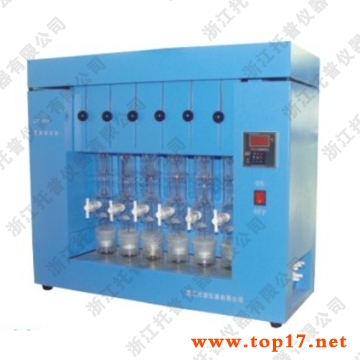The fat extraction instrument is a fat measurement instrument developed and manufactured based on the principle of Soxhlet extraction. Because Soxhlet extraction is convenient and quick, the fat extraction instrument uses this principle to determine the fat content in foods, etc. It will have more advantages and will be applied more widely. The working process of the fat extractor is to achieve the separation of the target (such as fat) by leaching the sample at the appropriate temperature. The use of a fat extraction apparatus to perform fat extraction can be mainly performed in four steps.

1. Soaking phase The first step is the soaking phase of the sample to be tested. At this time, the sample will be immersed in boiling petroleum ether or anhydrous ether, and most of the solubles will be leached.
2. Recirculation phase In the reflux phase, the sample is lifted above the solvent level and the evaporated solvent is condensed and returned to the filter paper drum to rinse the sample.
3. Solvent Recovery After the leaching is completed, the solvent is recovered in the solvent recovery bottle. Only the solubles to be leached remain in the leach cup.
4. Fat extraction is completed After the fat extraction is completed, the extraction cup is raised and removed from the heating plate to prevent the fat from being oxidized.
The above are the four main steps in the fat extraction experiment analysis of the fat extraction apparatus. In general, the fat extraction apparatus is mainly composed of a leaching unit and a control unit. The main function of the leaching unit is to automatically complete solvent leaching. The unit includes a heating plate, a condenser, a solvent addition carousel, a solvent recovery bottle and Buttons and other components; and the control unit is mainly used to set the parameters of the instrument, switch the condensate and display the working status of the instrument to ensure the function of the extraction unit and the normal operation of the instrument.

The Introduction of PCD
The PCD (Polycrystalline diamond) is a composite material, consisting of sintered diamond particles with a metallic binder. Diamond is the hardest material in absolute terms and therefore also the most resistant to abrasion. Used as a cutting tool, it has a good wear resistance, and a yield superior to traditional sharp carbide. The machined surface roughness with the PCD can reach comparable to the adjustment.
Main applications
â–²Processing of non-ferrous
â–²Aluminum alloys with high or low silicon content (pistons, engine blocks engine, wheels, carburetors, connecting rods, gear boxes, cylinders for brakes, etc.).
â–²Bronze and copper alloys (copper manifolds, engine bearings, bushings, connecting rods eyes, locations pumps etc.).
â–²Tungsten carbide (trafilatori rollers and other components sintered etc).
â–²Pieces composed of aluminum and lead, aluminum engine blocks with cast iron pipes reported
â–²Processing of non-metallic materials
â–²Very abrasive materials, such as ceramics industrial uncooked.
â–²Some fired ceramic: zirconia aluminum oxide, such as spark plugs and insulators.
â–²Glass, plastics with glass fibers, carbon fibers.
The Introduction of PCBN
PCBN has the characteristics of high thermal stability, high hardness, high wear resistance and. It`s inert to iron family element, hence PCBN is mainly used for the machining of high hardness and hard processed ferrous materials, such as d facing alloys, harden steel, pearlitic gray cast iron, high temperature alloy, high-speed steel, hard facing alloys, Ni-Cr alloy, powder metallurgy metals.
PCD/PCBN,Drilling PDC,PDC for Drill Bit,PDC for Bolting Bits
Henan Huanghe Whirlwind International Co., Ltd. , https://www.huangheindustry.com